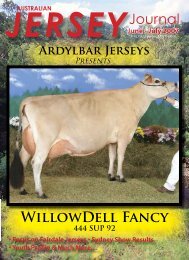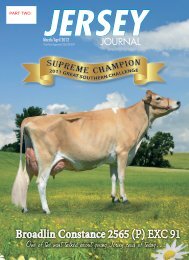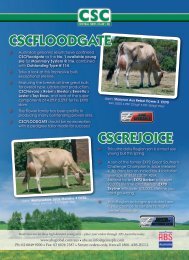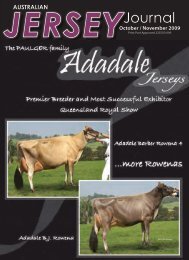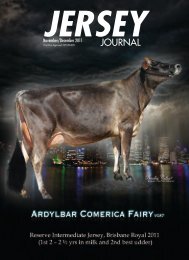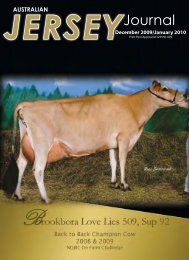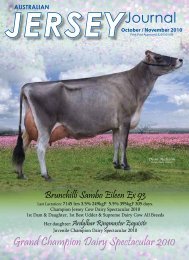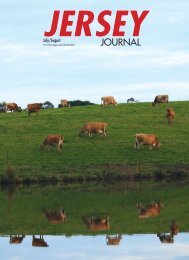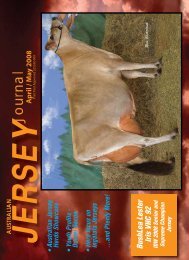5.8 - Australian Jersey Breeders Society
5.8 - Australian Jersey Breeders Society
5.8 - Australian Jersey Breeders Society
You also want an ePaper? Increase the reach of your titles
YUMPU automatically turns print PDFs into web optimized ePapers that Google loves.
words: Michael Porteous<br />
‘It’s a privilege<br />
to be a classifier’<br />
Queensland <strong>Jersey</strong> breeder Darrin<br />
Grevett says it’s a privilege to be a<br />
<strong>Jersey</strong> classifier and help breeders evolve<br />
the <strong>Australian</strong> <strong>Jersey</strong> herd.<br />
Darrin Grevett and son William with Sunshine Coast <strong>Jersey</strong> Cattle Club<br />
senior champion Yandavale Resserection Fayre.<br />
Darrin loves dairy farming and breeding and showing <strong>Jersey</strong>s.<br />
He enjoys traveling around Australia to meet other breeders,<br />
classify herds, and talk about breeding.<br />
Darrin’s grandparents were dairy farmers, but his family had<br />
left the industry by the time he grew up.<br />
“I didn’t really have any interest in dairy farming until I went<br />
to Nambour High School,” he says.<br />
Other Nambour old boys Kevin Rudd and Wayne Swan went<br />
on to become national leaders, but Darrin took the school’s Ag<br />
courses and came up with the idea of being a farmer.<br />
He then went to Gatton College to study grazing animal<br />
production. He couldn’t wait to apply theories on real farms.<br />
He began working for other dairy farmers 15 years ago, and<br />
eventually moved to his own farm at Eumundi, 30 minutes<br />
west of Noosa Heads.<br />
“My original love was for the Ayrshire cow,” Darrin says. “But<br />
their genetic base was just too small, and I wasn’t getting the<br />
results that I wanted when I was trying to breed.”<br />
But a high-school friend had a <strong>Jersey</strong> farm, and Darrin says he<br />
was involved with <strong>Jersey</strong>s when the breed was transformed<br />
by the introduction of American genetics. He remembers the<br />
first daughters of American bulls like Top Brass, and he saw<br />
the influence of the offspring of Lester.<br />
Now he says he likes all cows that are built right, but his<br />
heart is with <strong>Jersey</strong>s: “She’s a great converter of feed. Her<br />
temperament is great. The genetics are there. They are great<br />
cows.”<br />
Darrin now farms a 220-acre milking property with 80<br />
irrigated acres. He has another 200 acres of pastures 10kms<br />
away for heifers and drying-off cows.<br />
He milks 140 head – half <strong>Jersey</strong>s, and half Holsteins remaining<br />
from the 200-cow herd that came with the property. Darrin<br />
brought his own 80 <strong>Jersey</strong>s, and has been selling Holsteins.<br />
He says his top <strong>Jersey</strong> now produces 35 litres a day, and his<br />
top Holstein 40. After bad seasons last year, the farm was still<br />
buying in brewers grain in early spring, but was on track to<br />
produce 1.1 million litres this year.<br />
Darrin says the cows average 26 litres a day at four percent<br />
fat and 3.4 percent protein. He feels these are exceptional<br />
averages with the Holsteins in his herd.<br />
He says the main advantage of <strong>Jersey</strong>s on a farm north of<br />
Brisbane is that they handle humidity better than Holsteins.<br />
“The <strong>Jersey</strong>s are a lot smaller cow, and their colour helps,” he<br />
says. “They’ll be out grazing probably for an extra two hours<br />
16 <strong>Jersey</strong> Journal – January/February 2012




